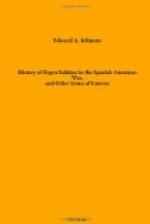Just before the charge, one of the foreign attaches, an Englishman, was heard to say that he did not see how the blockhouse was to be reached without the aid of cannon; but after the feat had been accomplished, a colored soldier said, “We showed him how.”
Now that the colored soldier has proven to this nation, and the representatives of others, that he can, and does fight, as well as the “other fellow,” and that he is also “competent” to command, it remains to be seen if the national government will give honor to whom honor is due, by honoring those deserving, with commissions.
Under the second call for volunteers by the President, the State of Illinois raised a regiment of colored soldiers, and Governor Tanner officered that regiment with colored officers from colonel down; and that, as you might say, before they had earned their “rank.” Now the question is, can the national government afford to do less by those, who have earned, and are justly entitled to, a place in the higher ranks? We shall see.
C.F. ANDERSON.
Springfield, Ill.
* * * * *
COLORED FIGHTERS AT SANTIAGO.
Testimony is multiplying of the bravery of the colored
troops at
Santiago de Cuba July 1st and 2d, 1898.
Testimony is adduced to show that these “marvels of warfare” actually fought without officers and executed movements under a galling fire which would have puzzled a recruit on parade ground. The Boston Journal of the 31st, in its account, gives the following interview-Mason Mitchell (white) said:
“We were in a valley when we started, but made at once for a trail running near the top of a ridge called La Quasina, several hundred feet high, which, with several others parallel to it, extended in the direction of Santiago. By a similar trail near the top of the ridge to our right several companies of Negro troopers of the Ninth and Tenth United States Cavalry marched in scout formation, as we did. We had an idea about where the Spaniards were and depended upon Cuban scouts to warn us but they did not do it. At about 8:30 o’clock in the morning we met a volley from the enemy, who were ambushed, not only on our ridge, but on the one to the right, beyond the Negro troops, and the Negro soldiers were under a cross fire. That is how Capt. Capron and Hamilton Fish were killed.”
It says: “Handsome young Sergt. Stewart, the Rough Rider protege of Henry W. Maxwell, when he was telling of the fight in the ambush, gave it as his opinion that the Rough Riders would have been whipped out if the Tenth Cavalry (colored) had not come up just in time to drive the Spaniards back. ’I’m a Southerner, from New Mexico, and I never thought much of the ‘nigger’ before. Now I know what they are made of. I respect them. They certainly can fight like the devil and they don’t care for bullets any more than they do for the leaves that shower down on them. I’ve changed my opinion of the colored folks, for all of the men that I saw fighting, there were none to beat the Tenth Cavalry and the colored infantry at Santiago, and I don’t mind saying so.’”




